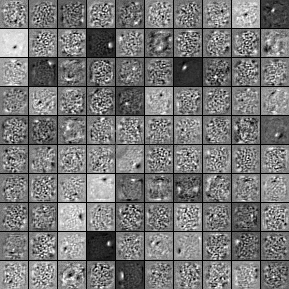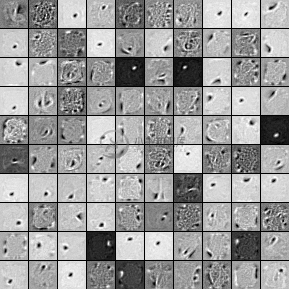降噪自动编码器
降噪自动编码器DA是在自动编码器的基础上,训练数据加入噪声,所以自动编码器必须学习去去除这种噪声而获得真正的没有被噪声污染过的输入。因此,这就迫使编码器去学习输入信号的更加鲁棒的表达,这也是它的泛化能力比一般编码器强的原因。DA可以通过梯度下降算法去训练。
The idea behind denoising autoencoders is simple. In order to force the hidden layer to discover more robust features and prevent it from simply learning the identity, we train the autoencoder to_reconstruct the input from a corrupted version of it_.
The denoising auto-encoder is a stochastic version of the auto-encoder. Intuitively, a denoising auto-encoder does two things: try to encode the input (preserve the information about the input), and try to undo the effect of a corruption process stochastically applied to the input of the auto-encoder. The latter can only be done by capturing the statistical dependencies between the inputs. The denoising auto-encoder can be understood from different perspectives (the manifold learning perspective, stochastic operator perspective, bottom-up – information theoretic perspective, top-down – generative model perspective), all of which are explained in[Vincent08]. See also section 7.2 of[Bengio09]for an overview of auto-encoders.
In[Vincent08], the stochastic corruption process randomly sets some of the inputs (as many as half of them) to zero. Hence the denoising auto-encoder is trying to_predict the corrupted (i.e. missing) values from the uncorrupted (i.e., non-missing) values_, for randomly selected subsets of missing patterns. Note how being able to predict any subset of variables from the rest is a sufficient condition for completely capturing the joint distribution between a set of variables (this is how Gibbs sampling works).
To convert the autoencoder class into a denoising autoencoder class, all we need to do is to add a stochastic corruption step operating on the input. The input can be corrupted in many ways, but in this tutorial we will stick to the original corruption mechanism of randomly masking entries of the input by making them zero. The code below does just that:
def get_corrupted_input(self, input, corruption_level):
"""This function keeps ``1-corruption_level`` entries of the inputs the
same and zero-out randomly selected subset of size ``corruption_level``
Note : first argument of theano.rng.binomial is the shape(size) of
random numbers that it should produce
second argument is the number of trials
third argument is the probability of success of any trial
this will produce an array of 0s and 1s where 1 has a
probability of 1 - ``corruption_level`` and 0 with
``corruption_level``
The binomial function return int64 data type by
default. int64 multiplicated by the input
type(floatX) always return float64. To keep all data
in floatX when floatX is float32, we set the dtype of
the binomial to floatX. As in our case the value of
the binomial is always 0 or 1, this don't change the
result. This is needed to allow the gpu to work
correctly as it only support float32 for now.
"""
return self.theano_rng.binomial(size=input.shape, n=1,
p=1 - corruption_level,
dtype=theano.config.floatX) * input
In the stacked autoencoder class (Stacked Autoencoders) the weights of thedAclass have to be shared with those of a corresponding sigmoid layer. For this reason, the constructor of thedAalso gets Theano variables pointing to the shared parameters. If those parameters are left toNone, new ones will be constructed.
The final denoising autoencoder class becomes:
class dA(object):
"""Denoising Auto-Encoder class (dA)
A denoising autoencoders tries to reconstruct the input from a corrupted
version of it by projecting it first in a latent space and reprojecting
it afterwards back in the input space. Please refer to Vincent et al.,2008
for more details. If x is the input then equation (1) computes a partially
destroyed version of x by means of a stochastic mapping q_D. Equation (2)
computes the projection of the input into the latent space. Equation (3)
computes the reconstruction of the input, while equation (4) computes the
reconstruction error.
.. math::
\tilde{x} ~ q_D(\tilde{x}|x) (1)
y = s(W \tilde{x} + b) (2)
x = s(W' y + b') (3)
L(x,z) = -sum_{k=1}^d [x_k \log z_k + (1-x_k) \log( 1-z_k)] (4)
"""
def __init__(
self,
numpy_rng,
theano_rng=None,
input=None,
n_visible=784,
n_hidden=500,
W=None,
bhid=None,
bvis=None
):
"""
Initialize the dA class by specifying the number of visible units (the
dimension d of the input ), the number of hidden units ( the dimension
d' of the latent or hidden space ) and the corruption level. The
constructor also receives symbolic variables for the input, weights and
bias. Such a symbolic variables are useful when, for example the input
is the result of some computations, or when weights are shared between
the dA and an MLP layer. When dealing with SdAs this always happens,
the dA on layer 2 gets as input the output of the dA on layer 1,
and the weights of the dA are used in the second stage of training
to construct an MLP.
:type numpy_rng: numpy.random.RandomState
:param numpy_rng: number random generator used to generate weights
:type theano_rng: theano.tensor.shared_randomstreams.RandomStreams
:param theano_rng: Theano random generator; if None is given one is
generated based on a seed drawn from `rng`
:type input: theano.tensor.TensorType
:param input: a symbolic description of the input or None for
standalone dA
:type n_visible: int
:param n_visible: number of visible units
:type n_hidden: int
:param n_hidden: number of hidden units
:type W: theano.tensor.TensorType
:param W: Theano variable pointing to a set of weights that should be
shared belong the dA and another architecture; if dA should
be standalone set this to None
:type bhid: theano.tensor.TensorType
:param bhid: Theano variable pointing to a set of biases VALUES (NULL,
high=4 * numpy.sqrt(6. / (n_hidden + n_visible)),
size=(n_visible, n_hidden)
),
dtype=theano.config.floatX
)
W = theano.shared(value=initial_W, name='W', borrow=True)
if not bvis:
bvis = theano.shared(
value=numpy.zeros(
n_visible,
dtype=theano.config.floatX
),
borrow=True
)
if not bhid:
bhid = theano.shared(
value=numpy.zeros(
n_hidden,
dtype=theano.config.floatX
),
name='b',
borrow=True
)
self.W = W
# b corresponds to the bias of the hidden
self.b = bhid
# b_prime corresponds to the bias of the visible
self.b_prime = bvis
# tied weights, therefore W_prime is W transpose
self.W_prime = self.W.T
self.theano_rng = theano_rng
# if no input is given, generate a variable representing the input
if input is None:
# we use a matrix because we expect a minibatch of several
# examples, each example being a row
self.x = T.dmatrix(name='input')
else:
self.x = input
self.params = [self.W, self.b, self.b_prime]
def get_corrupted_input(self, input, corruption_level):
"""This function keeps ``1-corruption_level`` entries of the inputs the
same and zero-out randomly selected subset of size ``corruption_level``
Note : first argument of theano.rng.binomial is the shape(size) of
random numbers that it should produce
second argument is the number of trials
third argument is the probability of success of any trial
this will produce an array of 0s and 1s where 1 has a
probability of 1 - ``corruption_level`` and 0 with
``corruption_level``
The binomial function return int64 data type by
default. int64 multiplicated by the input
type(floatX) always return float64. To keep all data
in floatX when floatX is float32, we set the dtype of
the binomial to floatX. As in our case the value of
the binomial is always 0 or 1, this don't change the
result. This is needed to allow the gpu to work
correctly as it only support float32 for now.
"""
return self.theano_rng.binomial(size=input.shape, n=1,
p=1 - corruption_level,
dtype=theano.config.floatX) * input
def get_hidden_values(self, input):
""" Computes the values of the hidden layer """
return T.nnet.sigmoid(T.dot(input, self.W) + self.b)
def get_reconstructed_input(self, hidden):
"""Computes the reconstructed input given the values of the
hidden layer
"""
return T.nnet.sigmoid(T.dot(hidden, self.W_prime) + self.b_prime)
def get_cost_updates(self, corruption_level, learning_rate):
""" This function computes the cost and the updates for one trainng
step of the dA """
tilde_x = self.get_corrupted_input(self.x, corruption_level)
y = self.get_hidden_values(tilde_x)
z = self.get_reconstructed_input(y)
# note : we sum over the size of a datapoint; if we are using
# minibatches, L will be a vector, with one entry per
# example in minibatch
L = - T.sum(self.x * T.log(z) + (1 - self.x) * T.log(1 - z), axis=1)
# note : L is now a vector, where each element is the
# cross-entropy cost of the reconstruction of the
# corresponding example of the minibatch. We need to
# compute the average of all these to get the cost of
# the minibatch
cost = T.mean(L)
# compute the gradients of the cost of the `dA` with respect
# to its parameters
gparams = T.grad(cost, self.params)
# generate the list of updates
updates = [
(param, param - learning_rate * gparam)
for param, gparam in zip(self.params, gparams)
]
return (cost, updates)
Putting it All Together
It is easy now to construct an instance of ourdAclass and train it.
# allocate symbolic variables for the data
index = T.lscalar() # index to a [mini]batch
x = T.matrix('x') # the data is presented as rasterized images
#####################################
# BUILDING THE MODEL CORRUPTION 30% #
#####################################
rng = numpy.random.RandomState(123)
theano_rng = RandomStreams(rng.randint(2 ** 30))
da = dA(
numpy_rng=rng,
theano_rng=theano_rng,
input=x,
n_visible=28 * 28,
n_hidden=500
)
cost, updates = da.get_cost_updates(
corruption_level=0.3,
learning_rate=learning_rate
)
train_da = theano.function(
[index],
cost,
updates=updates,
givens={
x: train_set_x[index * batch_size: (index + 1) * batch_size]
}
)
start_time = timeit.default_timer()
############
# TRAINING #
############
# go through training epochs
for epoch in range(training_epochs):
# go through trainng set
c = []
for batch_index in range(n_train_batches):
c.append(train_da(batch_index))
print('Training epoch %d, cost ' % epoch, numpy.mean(c, dtype='float64'))
end_time = timeit.default_timer()
training_time = (end_time - start_time)
print(('The 30% corruption code for file ' +
os.path.split(__file__)[1] +
' ran for %.2fm' % (training_time / 60.)), file=sys.stderr)
In order to get a feeling of what the network learned we are going to plot the filters (defined by the weight matrix). Bear in mind, however, that this does not provide the entire story, since we neglect the biases and plot the weights up to a multiplicative constant (weights are converted to values between 0 and 1).
To plot our filters we will need the help oftile_raster_images(seePlotting Samples and Filters) so we urge the reader to study it. Also using the help of the Python Image Library, the following lines of code will save the filters as an image:
image = Image.fromarray(tile_raster_images(
X=da.W.get_value(borrow=True).T,
img_shape=(28, 28), tile_shape=(10, 10),
tile_spacing=(1, 1)))
image.save('filters_corruption_30.png')
Running the Code
To run the code:
python dA.py
The resulted filters when we do not use any noise are:
The filters for 30 percent noise:



